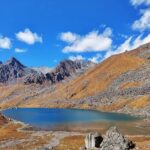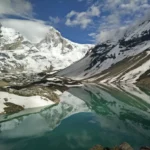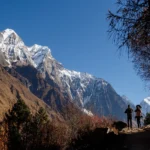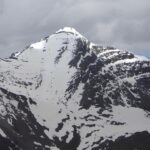Trekking shoes play a vital role in a Himalayan Trek. It is an essential gear for any Himalayan adventure. Whether on a high-altitude Himalayan trek or out to explore a leisurely weekend hike, a reliable pair of best trekking shoes can truly enhance your trekking experiences. Selecting the right pair of hiking shoes can turn your trek into a blissful experience. However, buying a random pair of shoes without thorough research can give you unwanted blisters on the hike, hampering your pace and ruining your getaway to the mountains.
If you are eyeing a good pair of trekking shoes for your next adventure, look no further – we have got you covered. The Outdoors is a diverse place. From challenging mountains to the undulated trail, the muddy path to winding terrain to tricky patches, and the gurgling streams. To enjoy the diverse landscapes the outdoors offer, having the right pair of footwear is essential.
Different types of terrain call for specific types of shoes. Let’s now explore the footwear you’ll need for various outdoor adventures in the mountains.
Before we delve into the shoes you should consider, let’s familiarize ourselves with the various types of outdoor shoes and how they differentiate themselves from one another.
Types of Trekking Shoes
If you are a beginner exploring short hikes over the weekend, hiking shoes will serve your needs. Multiday treks spreading for over a week in rugged and undulated terrain require trekking shoes to navigate the diverse landscapes comfortably.
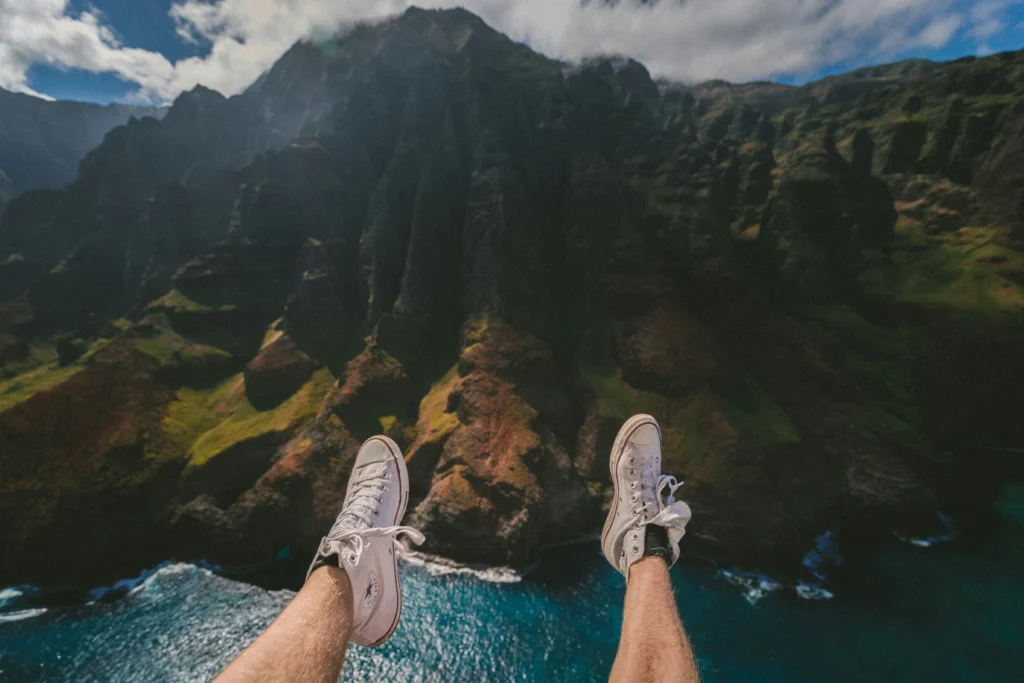
Expedition or mountaineering boots are suitable for people who are regularly on expeditions in the mountains. Let’s understand which shoes fit you the best.
1. Hiking shoes
What we like in Hiking Shoes
- Lightweight and breathable
- Suitable for a weekend trek
- Average grip
- Budget-friendly
What is missing? Water resistance & Adequate ankle support
The hiking shoes are perfect for short trails and doable over a weekend. Hiking shoes offer you the comfort of traversing on undulated terrain. For a short hike like Deoban or Chakrata trails, you can consider exploring in your hiking shoes.
The disadvantages of hiking shoes are they are not meant for tricky trails and lack water resistance. Wearing hiking shoes for a treka like Buran Ghati Trek or Roopkund Trek is a big no!
When you upgrade from weekend treks to high-altitude Himalayan treks, your shoes also need an upgrade. That’s where trekking shoes come into the picture. A pair of comfortable hiking shoes in India will cost anywhere from Rs 1500 to Rs 3000.
2. Trekking Shoes
What do we like in Trekking Shoes
- Lightweight and breathable
- Suitable for multiday treks (5 to 8 days)
- Good traction and grip
- Budget-friendly (4 -7k)
- Comfortable cushioning
- Midrise ankle support
- Water-resistant
Trekking shoes are perfect for treks that take you to tricky terrain and continue for more than 4 days. A good pair of trekking shoes will make traversing undulated terrain an easy task. It ensures better ankle support and a stronger grip and avoids ankle twisting, a common injury on rough terrain.
A quality pair of shoes will not hamper your trek whether it’s raining or snowing outside as they have a waterproof finish.
Buran Ghati and Gaumukh Tapovan, a comfortable pair of trekking shoes is a must. Treks that spread over more than a week require comfortable and sturdy trekking shoes that reduce the burden on your feet and support your ankle on steep ascents and descents.
A durable pair with effective water resistance trekking shoes in India begins at Rs 4500 to Rs. 7000.
3. Expedition Shoes
What do we like in Expedition Boots
- Lightweight and breathable
- Suitable for Expedition
- Excellent Grip and Traction
- Shock and abrasion-resistant
- Excellent waterproof to brave extreme weather conditions
- Expensive
- Comfortable insulation for cold temperatures
Expedition boots are for mountaineers and climbers who are regularly on long expeditions of multiple days. These shoes can brace all kinds of weather conditions and are apt for navigating high mountains buried under snow, slippery ice, glaciers, and rocky patches common in long expeditions. These shoes are expensive. Comes with excellent ankle support and waterproofing required to navigate snow-covered mountains.
However, they are priced on the slightly higher side. Invest in these shoes if you plan to join on expeditions and technically challenging Himalayan treks.
Here is a quick look at the difference between different types of outdoor shoes.
| Hiking Shoes | Trekking Shoes | Expedition/Mountaineering Boots |
| Flexible sole | Flexible and anti-skid sole | Anti Slip sole |
| Low Ankle Support | Mid Ankle Support | Advanced and high ankle supported |
| Average cushioning and breathable | Comfortable cushioning | Insulated cushioning for extreme weather situations |
| Average Grip | Deep grooves and strong grip | Advanced grip, abrasion resistant for challenging terrain |
| Works for a weekend and short hikes | Suitable for weeklong/multiple days treks in the Himalayas and monsoon treks | Suitable for long treks and extended expeditions across all weather conditions |
| Not water resistant | Offers good water resistance | Excellent water resistance in all weather conditions |
Now that you have sufficient knowledge of trekking shoe types, here are important factors to consider before choosing the right pair.
Key Feature of Trekking Shoes
1. Grip
To determine the grip of your shoes check the sole of your shoes and observe the depth of the grooves. The tracks enhance friction and provide a firm grip while walking on muddy and uneven terrain. The deeper the lugs ensure a strong hold on the ground. When trekking in rugged terrain like the Himalayas, it is essential to have shoes with deeper grooves for better grip and to avoid slipping on the trail. A better grip ensures stability while navigating in the Himalayas.
2. Flexible Sole
The flexibility of your sole is of utmost importance, particularly when navigating steep ascents and descents during a trek. A soft and flexible sole acts as the best friend your shoe needs in all kinds of terrain. It provides cushioning and protects you from any abrasive shocks that you face on an uneven trail.
To check whether your sole is flexible enough, perform a small test. If your sole is soft enough, it will make a dull sound when you tap a key or a pin on it. If it makes a sharp sound, look for another pair of shoes.
3. Water Resistance
It is extremely crucial to check whether your trekking shoes are water-resistant or not. Whether you are trekking during winter, monsoon, or summer, your trekking shoes must protect you from wet terrain. You will be crossing streams. There will be unpredictable rainfall, and you often have to navigate through a swampy trail. Up in the mountains, there will be no demarcated trail, and you will have to traverse the wet regions too.
This feature of your shoes can save you from unnecessary blisters or corn. Wearing wet shoes can cause these blisters and ruin your experience. Investing in water-resistant trekking shoes not only keeps your feet safe and dry but ensures comfort even on a rainy day.
4. Ankle Support
There is no smooth path in the Himalayas. For rugged terrain and heavy backpacking on multiday treks, ankle support becomes vital. On an uneven path probability of getting your ankle sprained is at an all-time high.
To prevent painful ankle twists on uneven trails, all you need to do is choose the perfect pair of shoes that guard your ankle throughout the trail.
Mid-cut models: This is the perfect category for a trek in the Himalayas. These models offer more ankle support and balance than the low-cut ones. These mid-rise ankle boots also offer a better buffer from the debris lying on the trail. Most trekking boots are designed this way and come with a robust construction to keep you going, irrespective of how rough the terrain gets.
5. The Right Fit
A lot of first-time buyers commit this mistake and end up buying the wrong fit.
Your trekking shoe should be snug but not too tight. Unlike sports shoes, it is suggested to go for a size bigger than your regular shoes.
Opting for a size bigger than your normal size provides breathing space for your toes to move freely. On a Himalayan trek, the route will be a mix of ascents and descents, and you also deal with sections of boulders. Such terrain requires your shoes to have some extra space to avoid blisters and shoe bites. A constant rubbing of your toe to the shoe wall can be problematic when you walk an average of 5-8 km a day. There should be plenty of wiggle room for your toes to avoid any painful blisters or swelling. Your toes are not supposed to reach the front of the shoe when laced up.
Budget to consider while buying trekking shoes
If you are an occasional hiker who hikes once or twice a year, there is no need to invest a big amount in expensive trekking shoes. Sturdy hiking shoes suffice for weekend treks or easy Himalayan treks. You can budget your shoes between Rs 2000 to Rs 4000.
Budget for Trekking Shoes
Regular trekkers who frequent the mountains on a high-altitude trek spanning over 5 days should opt for trekking shoes with mid or high-ankle support to ensure comfort. These pairs are available in the range of Rs 4000- Rs.7000 and offer a balance between quality and affordability, catering to the needs of frequent trekkers. High-end brands like Salmon and Salewa entail a further increase in your budget. These top brands offer exceptional performance and durability.
Budget for Expedition Shoes
For seasoned trekkers and mountaineers who frequently embark on multi-day long expeditions in challenging terrain, it’s worth investing a higher budget in expedition shoes.
Expedition or mountaineering boots with inner insulations and high ankle support cost you anywhere between Rs 6500 to Rs 12000. Opting for top-tier brands like Salomon, Salewa, and La Sportiva ensures comfort and durability in demanding terrain and extreme weather conditions. Advanced features and high guarantee paramount comfort on intense and extended trekking adventures. However, trekkers should be prepared to further increase their budget.
Factors to consider before purchasing trekking shoes
Trekkers are often confused when buying trekking shoes and arrive at impulsive choices without considering essential factors. To ensure you select the appropriate pair for your hike or trek, keep the following key factors in mind.
1. The terrain of the trek
It is crucial to consider the terrain you are heading to while purchasing a pair of trekking shoes. Remember whether it’s a well-demarcated and paved trail or a tricky and technically challenging trail. If your trek is easy and beginner-friendly on a well-marked trail, you can go ahead with your hiking shoes. However, make sure it’s a dry season. Monsoon demands well-built and water-resistant shoes.
2. The weather on the trek
While selecting trek shoes, the weather is of utmost importance. In the mountains, rain and snow are unpredictable. Always consider the weather situation before zeroing down on your final buy.
If you are a frequent trekker attempting moderate to difficult treks, go for shoes with better grip and ankle support. It would be foolish to go on a monsoon trek wearing trekking shoes that lack water resistance. Insulated shoes are necessary for cold environments, while well-ventilated shoes are better for warm climates.
3. Duration of the trek
Now, are you going on an easy Himalayan trek of 3-4 days or a trek where you will be walking continuously for a week, sometimes more than a week? The longer the duration of your trek, the more comfortable your walking gear has to be. While selecting a pair of trekking shoes, ensure that your shoes can sustain long walking hours on various kinds of terrain.
Best Trekking Shoes Available in India
For first-time trekkers, navigating the wide array of options in the market to find the perfect pair of shoes can be a daunting task. To ease the process, we reached out to experienced trekkers and outdoor enthusiasts to discover their favourite hiking and trekking shoes available in India. The following brands are highly recommended by both beginners and seasoned trekkers due to their excellent performance on Himalayan treks.
1. Quechua MH 100
Price – Around Rs 4,999/-
Available on Decathlon Online and in stores
This shoe is rated 4.3 out of 5 on Decathlon. Comes with a rubber outsole that ensures good traction and grip on steep descents. The water resistance of the shoe falters, especially if you are trekking in monsoon for long days. Can be relied on for treks like Dayara Bugyal and Kedarkantha if trekking in the dry season.
Reasons to buy
- Rubber outsole with good traction
- Mid ankle support
What is missing?
- No adequate cushioning
- Lacks functional water resistance
2. Forclaz Trek 100 Men
Price- Rs 6,999/-
Available on Decathlon Online and at stores
With a solid four out of five ratings, the Forclaz Trek 100 men’s hiking shoes offer exceptional ankle support, particularly on rugged and uneven terrain. The water resistance level is reliable. If it rains incessantly, the shoes tend to get drenched. Trekkers have also complained about the inner cushioning of the shoes causing pain in the toe, especially while descending.
This pair works excellently for easy-to-moderate Himalayan Treks.
Reasons to buy
- Rubber outsole with good traction
- Mid ankle support
- Functional Water resistance
- Breathable material
What is missing?
- Slightly expensive
- Enough room for your toes
3. AdidasTerrex AX4 Trekking Shoes
MRP – Rs 11,999/-
Available on the Adidas online
We have seen a few trekkers using these shoes on moderate treks like Kashmir Great Lakes.
The product works excellently on rocky scree and loose trails. It is abrasion-resistant and lightweight. Comes with a good grip, and works on steep terrain.
Adidas Terrex provides excellent comfort to your feet on multi-day treks. The cushioning is excellent, water resistance is great up to the ankle, and I completed two Himalayan Treks in this pair despite having 3 corns in my feet, shares Aditya swears by the comfort of Adidas trekking shoes.
Reason to buy
- Rubber outsole for better traction and grip on rocky terrain
- Eva midsole ensures underfoot comfort
- The upper material of mess and synthetic – ensures ventilation and breathability
What is missing-
- Better ankle support
- Slightly expensive
4. Quechua MH500
Price – Rs 5,499/-
Available on Decathlon online and at stores
Quechua MH500 by Decathlon is an excellent pair of shoes for an easy-to-moderate trek. The grip is good and the cushioning is comfortable. Water resistance is moderate. If you encounter heavy rainfall continuously, you can get blisters. For mild showers and muddy trails, the shoes keep your feet dry. Stable Ankle support helps to avoid twisting ankles on rocky undulated terrain. The setback of this pair is inadequate cushioning on the front of the shoe. The constant rubbing of the toe on the shoe wall causes pain.
5. Men Gabbro Pro Mid-Top Trekking Shoes
Price – Rs 3,995/-
Available on Wildcraft, Amazon, Myntra, and Flipkart
This model by Wildcraft comes with a mid-top style assuring stable ankle support on challenging trails. Textured deep grooves ensure your grip is strong while descending on slippery trails. The cushioned footbed is reliable and comfortable. These wildcraft trekking shoes work for easy-to-moderate Himalayan treks spreading over 5 – 7 days.
6. Men High Ankle Shoe Amphibia Sphere 2
Price – Rs 6,495/-
Available on Wildcraft, Amazon, Myntra, and Flipkart
Designed with leather upper material, the shoe is water resistant and keeps your feet dry while navigating wet terrain. The cushioning is well-built and the deep lugs ensure excellent grip. The mid-ankle support assures your descent is injury-free. The toe protection is reliable on rough terrain and assures top-notch comfort.
Its disadvantage is its weight and its performance on challenging terrain.
In addition to the mentioned brands, trekkers also use products from Bata, Liberty, Woodland, and Columbia, among others, especially beginner-friendly treks. While Columbia trekking shoes are priced at a higher rate, other brands mentioned are budget-friendly and worth trying for your trekking needs. However, consider above mentioned factors before finalizing your pair from these brands.

